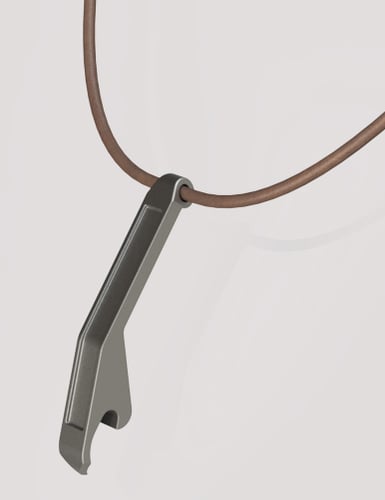What Did We Make and Why - Concepting/Ideation
This is the second blog post in a three part series. We are picking up where we left off from our Problem Statement post here.
Recap
In the previous post we ended with this problem statement: “Soda cans require the consumer to have a can opener to dispense.” We arrived here from a thought experiment in which we were reinventing the soda pull-tab can opener (and trying to avoid inventing can-opener necklaces).
Let’s get to it...
Now that we have the solid foundation of a well thought out and intentional problem statement, it’s time to start forming ideas on how to solve the problem. This is by far my favorite part of the product development process and requires the most intentional creativity. The purpose of this post is to go over a few important strategies on how to get the most out of a concepting and ideation stage.
Ideation
The ideation process can be broken up into a few sub stages: researching, brainstorming, categorizing, and down selecting.
It’s a good idea to always start with research. You may immediately find out that a supposedly novel solution already exists as a product or a patent--this can be disappointing but useful information to avoid investing time and money on something that already exists. On the upside, this could also lead you down a path to potentially improve upon the existing idea. For this blog post though, we will focus on developing a new product.
The value of fully researching the problem and any proposed solutions cannot be understated. If you do thorough research before and during the ideation process then that enables you to think about and speak about your proposed ideas with higher value and likelihood of success.
The most fun portion of the entire product development process is undoubtedly brainstorming. Brainstorming works the best (from my experience) in a group of 3-4 people. In practice, this proves to be a large enough group to keep the ideas fresh and flowing but not too large so as to mute participants and lose potential ideas. When entering into a concepting session, there is one extremely important rule that everyone must agree to and abide by. For a successful session, it is critical that we agree there are no bad ideas. Nothing gets ruled out or picked apart for flaws during brainstorming--that comes later.
You never know what imperfect idea might spur a thought in one of your co-brainstormers in the session. It’s rare that ideas start off as readily accepted and polished solutions, so keep an open mind. For this stage, throw as many ideas as possible at a white board and let them all stick, for now.
While brainstorming, it can be helpful to break out and categorize some topics to help tailor constructive ideas. Using the pull-tab as an example here are some categories that I may use: opening technique and opening area.
| Opening technique | Defining the opening area |
| lever | perforated |
| punch | laser etched |
| pin | stamped |
| micro explosive | machined |
| chemical reaction | pre fatigued |
| shaking causing pressure build up | small gap that is sealed |
| top, bottom, side of can? |
It is also important to categorize requirements, nice to haves, manufacturing techniques, and list of questions. These are very helpful for prioritizing what is necessary and should be focused on and what would be nice to have. Going into a brainstorming session with requirements can help structure the session and keep it constructive and somewhat organized.
| Requirements | Nice to haves | Manufacturing Methods | List of Questions |
| no tools required | one handed operation | stamping | what pressure must the seal maintain |
| no sharp edges before or after can is open | resealable | machining | |
| casting |
Though we don’t need to discuss it much here, there are a number of brainstorming techniques useful for difficult problem solving, especially when ideas don’t seem to be flowing. For a more systematic approach to innovation (and one that we admittedly don’t use much), check out TRIZ. With 40 “inventive principles,” TRIZ can help get ideas flowing or provide avenues for solving problems that might not be immediately obvious: https://triz-journal.com/contradiction-matrix/
The Decision Matrix
Down selecting is arguably the most important portion of the ideation process. It is where you go from all the ideas to (hopefully) a few good ones. There are many different methods available to help with this process but they are mostly some form of a decision matrix where you rank your ideas against each other in defined criteria. The criteria typically have a weight associated with them to help highlight the importance of the criteria. After ranking the ideas in each category you should get a few that stand out (highest numerical value) as worth pursuing.
|
Pull Tab Opening Technique |
|||||||
|
weighting: 1-5, 5 being highest importance |
lever |
punch |
pin |
micro explosive |
chemical reaction |
shaking causing pressure build up |
|
|
4 |
cost |
5 |
3 |
4 |
2 |
2 |
5 |
|
3 |
manufacturability |
3 |
2 |
3 |
1 |
2 |
2 |
|
4 |
scalability |
5 |
4 |
5 |
2 |
3 |
2 |
|
4 |
reliability |
4 |
3 |
3 |
3 |
1 |
1 |
|
5 |
safety |
4 |
3 |
3 |
1 |
1 |
1 |
|
2 |
noise |
4 |
3 |
4 |
1 |
5 |
1 |
|
2 |
engineering effort |
3 |
4 |
4 |
2 |
1 |
1 |
|
Weighted total |
99 |
75 |
88 |
42 |
47 |
43 |
|
|
Pull Tab Opening Area |
|||||||
|
weighting: 1-5, 5 being highest importance |
perforated |
laser etched |
stamped |
machined |
pre fatigued |
small gap that is sealed |
|
|
4 |
cost |
4 |
3 |
5 |
2 |
2 |
1 |
|
3 |
manufacturability |
4 |
3 |
5 |
5 |
1 |
2 |
|
4 |
scalability |
5 |
3 |
5 |
3 |
2 |
2 |
|
4 |
reliability |
4 |
3 |
4 |
5 |
3 |
2 |
|
5 |
safety |
2 |
3 |
3 |
3 |
3 |
5 |
|
2 |
noise |
4 |
2 |
3 |
2 |
2 |
5 |
|
2 |
engineering effort |
3 |
3 |
4 |
4 |
1 |
2 |
|
Weighted total |
88 |
70 |
100 |
82 |
52 |
65 |
|
Looking at the table above, we can see that the micro-explosive opening technique rates pretty poorly for cost and safety, understandably. Those two factors contribute 8 = (2 x 4) and 3 = (1x3) to the weighted total of 42 for that opening technique. At this point, these are very subjective criteria. If we were to weight “safety” down to 1 and add a “coolness factor” weighted at 10 (outside of our scale), then the micro-explosive technique would fare much better!
Conclusion
After throwing all the ideas at the board and down selecting, we came to the conclusion that a lever operated and stamped constructed pull tab would have the greatest chance of success based on our defined criteria. It is often useful to put more thought into the top few ideas. Don’t focus solely on the top idea from the decision matrix. Sometimes you can learn important lessons from advancing the top few ideas or you can have a good backup plan in case a road-block manifests for the favored solution as design progresses. In any case, the decision matrix usually does a very good job of eliminating ideas that are likely not worth further thought and time.
Interested in learning more about Boulder Engineering Studio? Let's chat!
Previous Blog Posts
What Did We Make and Why - The Problem Statement |
CCTW Award Winner 2020 |

|

|
Opening technique
.svg)







